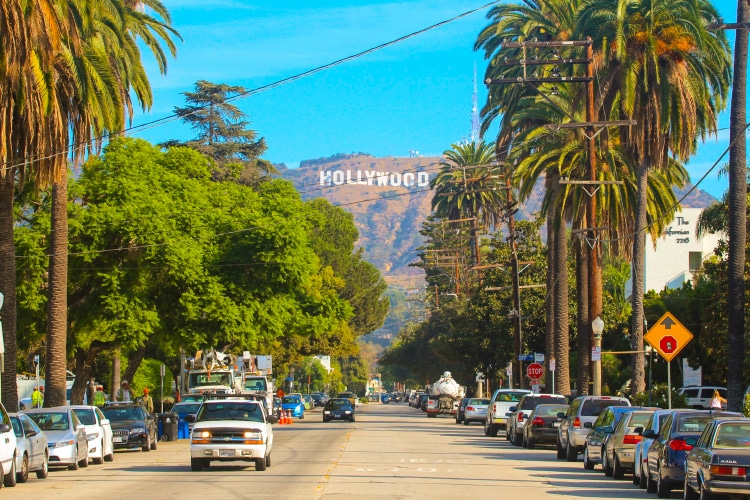When it comes to climate change, Los Angeles is the tip of the spear.
Since the industrial revolution, the city’s average temperature has climbed 4.1°F. Even with immediate and drastic action, some warming is inevitable in the next few decades.
If left unchecked, some parts of Los Angeles could warm by as much as 8°F by 2050, according to the UCLA Institute of the Environment and Sustainability. By 2100, half of all days in Riverside could be warmer than 95°F.
While emissions are decreasing overall, rising emissions in some sectors—especially transportation—are already putting the state well behind its goals for 2030.
Tackling climate change in Los Angeles is a particularly daunting task, which means other states and cities can learn from how the city is trying to solve the problem.
Southern California is one of the fastest-warming areas in the United States. No single intervention will be enough to curb warming and keep temperatures safe for Los Angeles residents. Instead, scientists and city planners must rely on a comprehensive strategy that accomplishes compounding marginal gains at every possible point.
Urban forestry
One area that the city has chosen to focus on is trees. The Los Angeles Bureau of Street Services—or “StreetsLA”—is tasked with maintaining the street, sidewalks and trees of the city, which the bureau says makes up the “largest municipal urban forest in the country.”
In addition to removing greenhouse gases from the air, trees offer shade and their leaves also release cooling water into the air, all of which can add up to a cooling effect as high as 10°F, according to a 2019 study in PNAS.
Trees are an important part of a holistic approach to tackling climate change in Los Angeles. Still, more trees doesn’t guaranteed salvation, and planting them should never be used as a way to shirk responsibility for reducing emissions.
The city is already fairly well-covered: As part of Los Angeles’ “Green New Deal”—which aims to reduce temperatures by 1.7 °F by the year 2025 and 3°F by 2035—Mayor Eric Garcetti has called for 90,000 new trees to be planted by the end of 2021. That’s a lot of new trees—around 100 per day—but the city currently boasts an estimated 10 million trees.
The average hardwood tree absorbs 48 pounds of CO2 per year, meaning a 90,000 new ones could scrub an additional 1,959 metric tons of carbon from the air. For context, Los Angeles produces an estimated 196 million metric tons of CO2 emissions per year.
But trees are valuable for reasons beyond reducing atmospheric CO2. In Los Angeles, their role has less to do with reducing carbon and more to do with creating shade and lowering local temperatures.
Encourage mass transit
StreetsLA is planning to plant trees in specific corridors that experience heavy foot traffic, especially along roads and paths that people walk en route to public transportation.
“Urban forestry is about finding a way to cool the first and last mile of transit connectivity to provide cool areas for people to go from their work to the bus stop, or from home to the park,” said Adel Hagekhalil, executive director and general manager of StreetsLA.
If trees can reduce the number of cars on the road by making it easier to take the bus or the train, they can help chip away at transportation emissions; if they can keep a neighborhood cooler, they can lower the energy demand for air conditioning.
What these gains equate to in carbon gains or reductions in warming is impossible to predict. But so far, slowing warming has proven to be a daunting task, and any little bit helps.
If trees can be deployed as shaders to keep the cities cooler and encourage people to take mass transportation, then they’re part of the solution. If they scrub some carbon from the air at the same time, all the better.
Other benefits
Beyond direct contributions to reducing a warming climate, trees offer myriad other tangential benefits.
They help capture storm water, play home to birds and other urban wildlife, and improve social cohesion in neighborhoods. In addition to focusing on areas that are particularly hot, the city is also targeting areas based on socioeconomic equity, said Greg Spotts, chief sustainability officer at StreetsLA.
Unsurprisingly, many of Los Angeles’ sparsest areas are also its poorest—and, consequently, its hottest. In light of this, Spotts said the bureau is using new tools like the Climate-Smart Cities Tool, developed by the Trust For Public Land, to identify underserved areas that might benefit the most from some added greenery.
“Trees make people feel good mentally, psychologically, physically,” Hagekhalil said. “We’re excited about making the city a safer and more resilient place in the face of climate change.”











